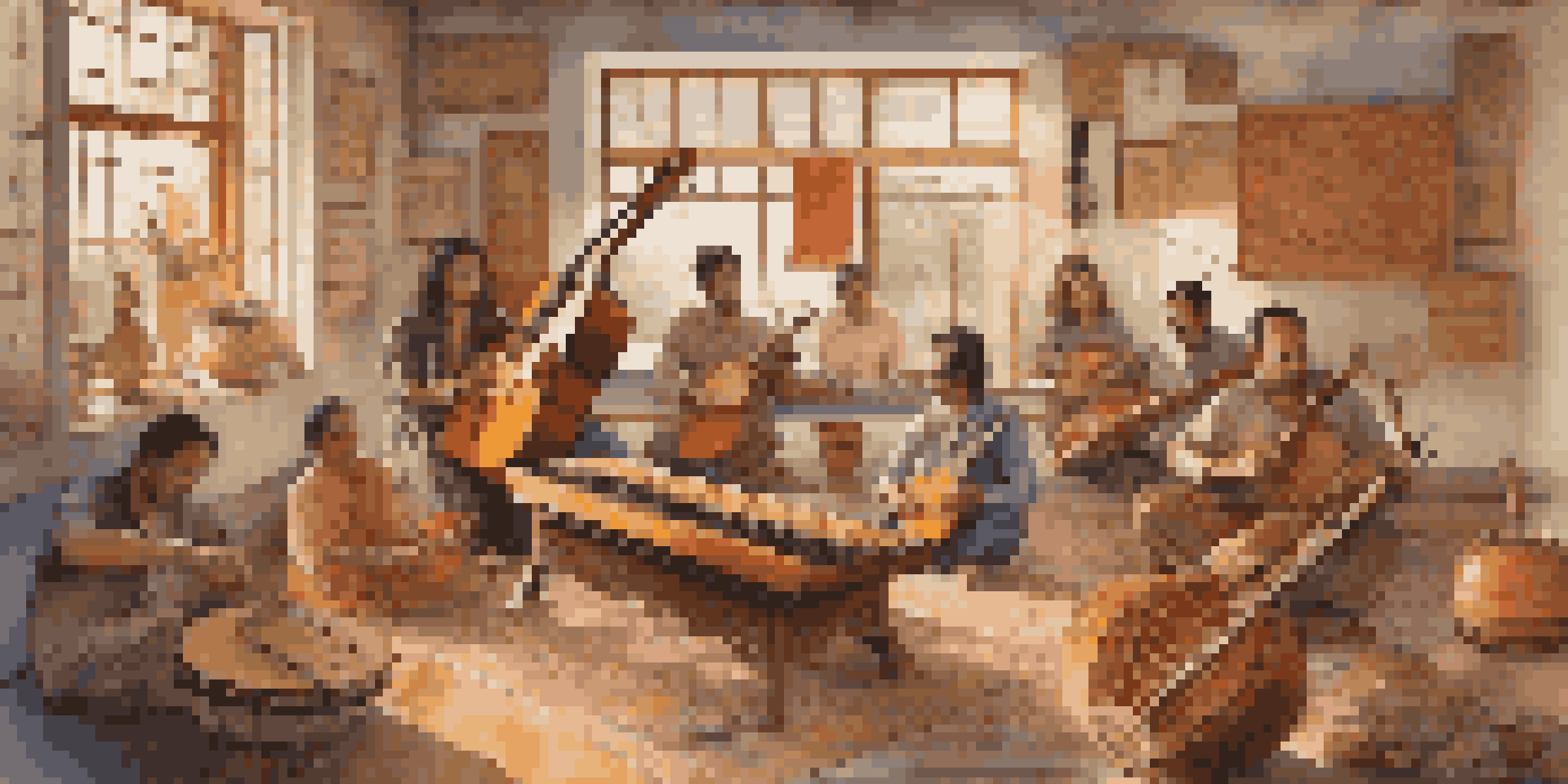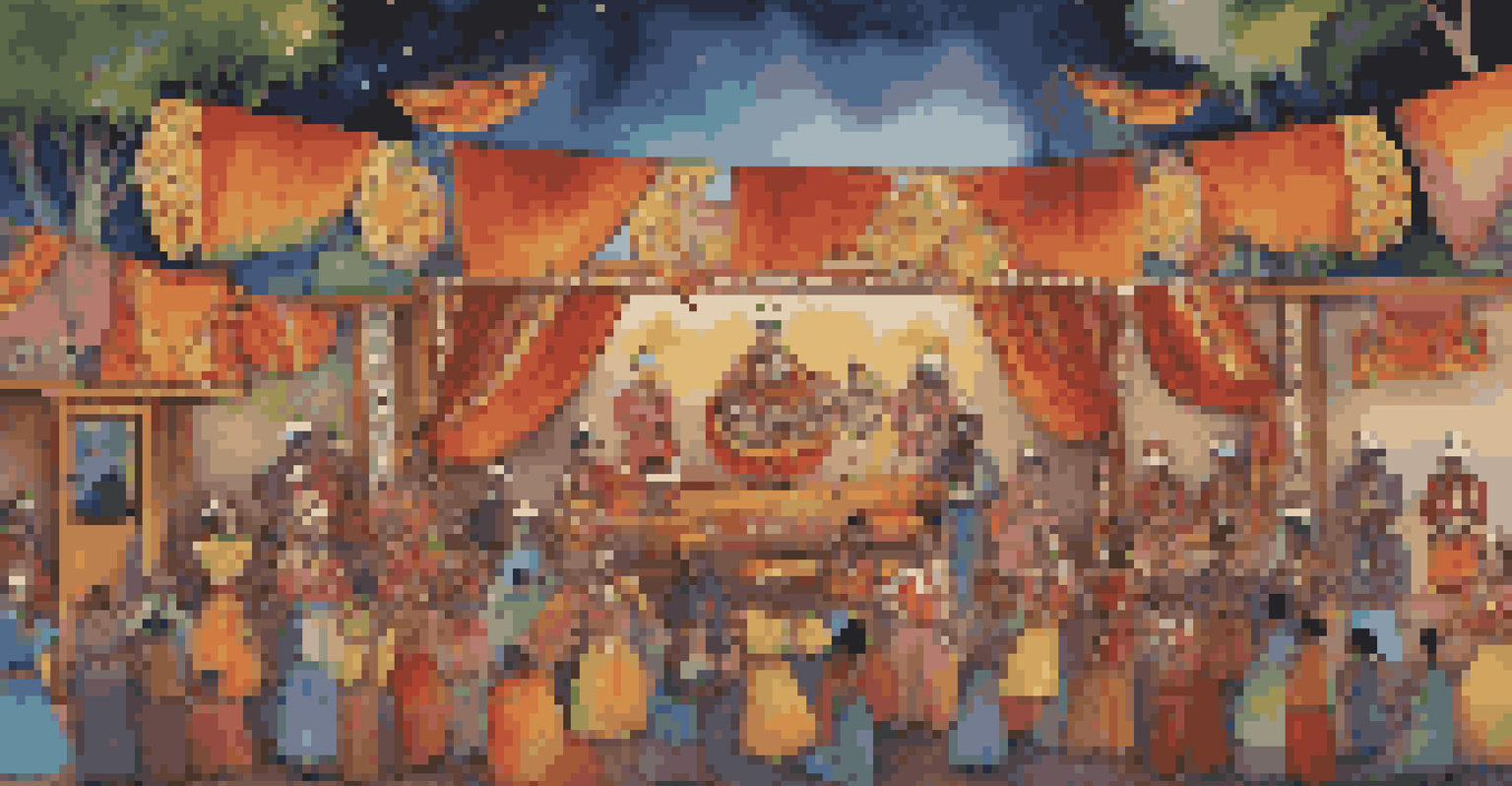The Influence of Traditional Music on Contemporary Composers

Understanding Traditional Music's Roots and Significance
Traditional music often serves as a cultural cornerstone, reflecting the values, beliefs, and history of a community. It encapsulates stories passed through generations, making it a rich source of inspiration for contemporary composers. By understanding these roots, modern musicians can connect with deep emotional and cultural narratives that resonate with audiences today.
Music can change the world because it can change people.
For instance, the rhythmic patterns of African drumming can evoke a sense of communal celebration, while the haunting melodies of Eastern European folk songs might stir feelings of nostalgia. These elements not only enrich a composer's toolkit but also bridge cultural divides, creating a shared musical language. In this way, traditional music remains a vital thread in the fabric of contemporary composition.
Moreover, as global communication increases, modern composers have access to an even wider array of traditional music styles. This exposure encourages them to experiment with different sounds and structures, leading to innovative fusions that keep the essence of traditional music alive while pushing artistic boundaries.
Cultural Fusion: Blending Old and New Sounds
Contemporary composers often draw from traditional music to create unique fusions that resonate with diverse audiences. This blending of styles allows them to craft new musical identities while paying homage to their influences. For example, artists like Yo-Yo Ma have successfully combined classical music with traditional Asian sounds to produce captivating performances that highlight the beauty of both worlds.

By incorporating elements such as scales, rhythms, and instruments from various traditions, composers can evoke emotions and atmospheres that might not be achievable through conventional means. This cultural fusion not only enriches the composer’s work but also invites listeners to explore and appreciate different musical heritages.
Traditional Music Inspires Innovation
Contemporary composers draw from traditional music to create unique fusions that resonate with today's audiences.
As a result, the boundaries of genres are blurred, leading to exciting collaborations and projects that showcase the best of both traditional and contemporary music. This dynamic interplay encourages creativity and experimentation, ultimately resulting in a more vibrant musical landscape.
The Role of Ethnomusicology in Modern Composition
Ethnomusicology, the study of music within its cultural context, plays a crucial role in understanding how traditional music influences contemporary composers. By examining the social and cultural significance of traditional music, composers can gain insights that inform their creative process. This academic discipline opens doors to new musical possibilities and fosters a deeper appreciation for the traditions they draw from.
The purpose of art is not a rarified, intellectual distillate; it is life, intensified, life, seen through a prism.
For example, contemporary composers who study the nuances of Indian classical music may incorporate specific ragas into their compositions, adding depth and authenticity to their work. This knowledge allows them to create music that not only sounds unique but also carries the weight of its cultural heritage.
Furthermore, ethnomusicologists often work closely with communities to document and preserve traditional music. This collaboration helps ensure that these musical forms continue to thrive, inspiring future generations of composers who may find their own voices within these time-honored traditions.
Inspiration from Traditional Instruments and Techniques
Many contemporary composers are inspired by traditional instruments and their unique sounds. Instruments such as the sitar, shamisen, or djembe offer tonal qualities and playing techniques that can profoundly influence a piece's character. By integrating these instruments into modern compositions, composers can create a distinctive sound palette that sets their work apart.
For instance, the use of the hang drum, a relatively new instrument inspired by traditional steel drums, has gained popularity among contemporary composers. Its soothing tones and melodic capabilities provide a fresh take on traditional percussion, allowing artists to explore new sonic landscapes. This integration of traditional instruments not only enhances the music but also introduces audiences to the beauty of these often-overlooked sounds.
Ethnomusicology Enhances Creativity
The study of music within its cultural context helps composers incorporate traditional elements authentically into their work.
Incorporating these instruments also invites a dialogue between the past and the present, reminding listeners of the rich history that informs contemporary art. As composers experiment with blending these traditional sounds into their work, they create a musical tapestry that honors the past while embracing the future.
Storytelling Through Traditional Music Elements
Storytelling is a fundamental aspect of traditional music, and contemporary composers often adopt these narrative techniques to engage listeners. By weaving tales through their music, they can evoke emotions and create vivid imagery, much like a traditional folk song would. This storytelling approach invites audiences to connect on a deeper level, allowing them to experience the music's journey.
For example, a composer might use a traditional folk melody as the foundation for a modern symphony, layering contemporary harmonies and rhythms while maintaining the original story's essence. This not only preserves the traditional narrative but also revitalizes it for a new audience, making it relevant and relatable in today's context.
By embracing these storytelling elements, composers can create rich, immersive experiences that resonate with listeners. This ability to blend traditional narratives with modern contexts fosters a sense of continuity in music, bridging generations and cultures through shared stories.
The Globalization of Music and Its Impact
Globalization has significantly changed the way traditional music influences contemporary composers. With easy access to music from around the world, composers can explore diverse styles and sounds, leading to a more interconnected musical landscape. This exposure allows them to experiment with various influences, often resulting in innovative and exciting compositions that reflect a global perspective.
For instance, the rise of world music festivals has introduced audiences to traditional sounds from different cultures, inspiring composers to incorporate these elements into their own work. This cross-pollination of ideas promotes cultural appreciation and encourages musicians to think beyond geographical boundaries when crafting their art.
Preserving Heritage Through Music
By integrating traditional sounds and techniques, contemporary musicians play a crucial role in keeping these art forms alive.
However, this globalization also raises questions about cultural appropriation. Composers must navigate these waters carefully, ensuring that they respect and honor the traditions they draw from while also making their contributions. Striking this balance fosters a richer dialogue between cultures and ensures that traditional music continues to influence contemporary composition in meaningful ways.
Preserving Traditional Music in Modern Composition
As contemporary composers draw from traditional music, they play a vital role in preserving these art forms. By incorporating traditional elements into their music, they help keep these sounds alive and relevant in a rapidly changing world. This preservation is crucial, as many traditional music styles face threats from modernization and globalization.
Composers can also actively participate in documenting and promoting traditional music, collaborating with musicians from various cultures to create new works that honor the past. Through this collaboration, they not only amplify the voices of traditional musicians but also educate listeners about the importance of cultural heritage.

Ultimately, this commitment to preservation ensures that traditional music continues to inspire future generations of composers and music lovers alike. By weaving these rich traditions into their compositions, contemporary musicians contribute to a vibrant musical ecosystem that celebrates both innovation and heritage.